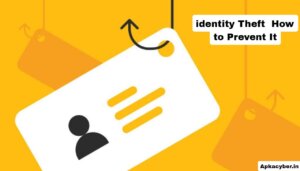
Introduction
In today’s increasingly digital world, the concept of personal security has taken on a whole new dimension. While physical security involves locking doors and safeguarding valuables, digital security requires a different set of precautions. One of the most serious and growing threats in the digital era is identity theft. Identity theft is a crime that can have devastating effects on individuals, families, and even businesses. It involves the unauthorized use of someone else’s personal information for fraudulent purposes. These may include applying for credit, filing taxes, or obtaining medical services. Victims of identity theft often face financial loss, damaged credit scores, and emotional distress.
Understanding what identity theft is, how it occurs, and how to protect oneself against it is crucial in today’s interconnected society. This essay explores the various forms of identity theft, how criminals gain access to personal information, and, most importantly, how individuals can safeguard themselves from becoming victims of this crime.
- Kotak Neo: A Complete Guide
- INDmoney: A Deep Dive into India’s All-in-One Financial Super App
- Supermoney Upi App Reward
- CoinDCX: India’s Leading Crypto Exchange
What is Identity Theft?
Identity theft occurs when someone illegally obtains and uses another person’s personal information without permission, typically for financial gain. This information might include a person’s name, Social Security number, credit card details, bank account information, or other data that can be used to impersonate someone else.
Identity theft is not a new crime, but with the rise of the internet and digital communications, the methods by which criminals commit this act have evolved significantly. In earlier times, thieves might have rummaged through trash bins looking for discarded documents with sensitive information. Today, identity thieves can breach online accounts, send phishing emails, and exploit data breaches to gather the information they need.
Types of Identity Theft
Identity theft comes in various forms, each targeting a different aspect of a victim’s life. Here are some of the most common types:
1. Financial Identity Theft
This is the most common type and involves using someone’s financial information to make purchases, open credit accounts, or take out loans. The thief may use the victim’s credit card number or open a new account in their name.
2. Medical Identity Theft
In this form, the thief uses someone’s identity to obtain medical services or prescription drugs. It can lead to false entries in the victim’s medical records, which can be dangerous in future medical emergencies.
3. Criminal Identity Theft
This occurs when an individual provides someone else’s name and personal information to law enforcement during an arrest or investigation. The real person might end up with a criminal record they know nothing about.
4. Child Identity Theft
Children are especially vulnerable targets because they usually have clean credit histories. Thieves can use a child’s Social Security number to apply for credit cards or take out loans that go undetected for years.
5. Synthetic Identity Theft
In this more complex form of identity theft, the criminal combines real and fake information to create a new identity. For example, they might use a real Social Security number with a fake name and birth date to open new accounts.
6. Tax Identity Theft
This happens when someone uses another person’s Social Security number to file a tax return and claim a refund fraudulently. Victims usually discover the fraud when their legitimate tax return is rejected.
How Does Identity Theft Happen?
Understanding how identity theft occurs is the first step in learning how to prevent it. Here are some common methods that criminals use:
1. Phishing and Email Scams
Phishing is a method where scammers send fake emails or messages pretending to be from legitimate companies, banks, or government agencies. These messages often prompt recipients to provide sensitive information such as passwords, credit card numbers, or login credentials.
2. Data Breaches
Data breaches occur when hackers gain access to a company’s or organization’s database, exposing customer information. Millions of people can be affected in a single breach, as seen in the cases of major corporations like Equifax, Target, and Marriott.
3. Skimming Devices
Thieves can attach skimming devices to ATMs or gas pumps to capture the data on your debit or credit card’s magnetic strip. They later use this information to make unauthorized purchases.
4. Dumpster Diving
Although less common today, some thieves still dig through trash looking for discarded bills, bank statements, or other documents containing personal information.
5. Public Wi-Fi Networks
Unsecured public Wi-Fi networks can be hotspots for hackers to intercept the information you send over the internet. Without encryption, data like login details or credit card numbers can be stolen.
6. Social Engineering
This involves manipulating people into giving up confidential information. Thieves might pose as technical support agents, bank representatives, or even friends to gain access to personal data.
Signs That You May Be a Victim of Identity Theft
Recognizing the early signs of identity theft can minimize the damage. Here are a few warning signs:
-
Unexpected withdrawals from your bank account
-
Unauthorized charges on your credit card
-
Calls from debt collectors for debts you don’t owe
-
Denial of credit despite having a good credit history
-
Notifications of a data breach from a company where you have an account
-
Receiving unfamiliar bills or credit cards in the mail
-
Errors on your credit report
The Consequences of Identity Theft
The impact of identity theft goes beyond financial loss. Victims may experience:
1. Financial Damage
Unauthorized transactions, unpaid debts, or loans taken out in the victim’s name can lead to significant financial loss. Victims might spend years repairing their credit.
2. Emotional Stress
Discovering that someone has stolen your identity can be emotionally distressing. Victims often feel violated, anxious, and overwhelmed.
3. Legal Issues
In some cases, victims may have to prove their innocence if the thief committed crimes using their identity. This can lead to legal costs and complications.
4. Loss of Time
Resolving identity theft is often a lengthy and complicated process that can take months or even years. It involves contacting banks, credit bureaus, and possibly law enforcement.
How to Prevent Identity Theft
Although identity theft can’t be completely prevented, there are many practical steps individuals can take to reduce their risk.
1. Protect Personal Information
Never share personal details like your Social Security number, bank account number, or passwords unless absolutely necessary. Be cautious when giving out this information, especially over the phone or internet.
2. Use Strong Passwords
Create unique, strong passwords for all your accounts. Avoid using easily guessed information like birthdates or simple sequences (e.g., “123456”). Consider using a password manager to store and generate secure passwords.
3. Enable Two-Factor Authentication
Two-factor authentication (2FA) adds an extra layer of protection to your online accounts. Even if someone gains access to your password, they will need a second form of verification (like a text message or app notification) to log in.
4. Monitor Your Financial Statements
Regularly check your bank and credit card statements for any unusual activity. The sooner you spot suspicious transactions, the faster you can take action.
5. Check Your Credit Reports
You are entitled to a free credit report from each of the three major credit bureaus—Experian, Equifax, and TransUnion—once a year. Reviewing your reports can help you spot accounts or activity you don’t recognize.
6. Shred Documents
Before discarding any documents that contain personal information, shred them. This includes bank statements, medical bills, and any mail that includes account numbers or identifying data.
7. Be Cautious Online
Avoid clicking on suspicious links in emails or on social media. Make sure websites are secure (look for “https” in the URL) before entering sensitive information. Avoid sharing personal details publicly on social media.
8. Secure Your Devices
Keep your devices secure with antivirus software, firewalls, and regular updates. Lock your phone or computer when not in use, and use encryption if available.
9. Avoid Public Wi-Fi for Sensitive Transactions
If you must use public Wi-Fi, avoid accessing sensitive accounts. Use a virtual private network (VPN) for added security.
10. Freeze Your Credit
If you suspect identity theft or simply want added protection, you can place a freeze on your credit reports. This prevents creditors from accessing your report, making it harder for identity thieves to open new accounts in your name.
What to Do If You’re a Victim of Identity Theft
If you believe your identity has been stolen, take action immediately:
-
Contact the companies where fraud occurred and ask them to freeze or close the fraudulent accounts.
-
Place a fraud alert on your credit report with one of the credit bureaus.
-
Report the theft to the Federal Trade Commission (FTC) via IdentityTheft.gov.
-
File a police report, especially if the identity theft has led to criminal charges or financial loss.
-
Review your credit reports to identify any additional suspicious activity.
-
Dispute any errors you find with the credit bureaus.
-
Keep records of all your communications and documents related to the theft.

Conclusion
Identity theft is a serious threat that affects millions of people every year. While it may not always be possible to eliminate the risk entirely, taking proactive steps can greatly reduce your chances of becoming a victim. Being informed, cautious, and vigilant are your best defenses.
By understanding the different forms of identity theft and how they occur, individuals can take meaningful action to protect their personal information. As technology continues to evolve, so too will the tactics used by cybercriminals. Therefore, it is essential to stay updated on best practices for digital security and to remain alert to signs of suspicious activity. Ultimately, safeguarding your identity is not just about protecting your finances—it’s about preserving your reputation, your peace of mind, and your future.
